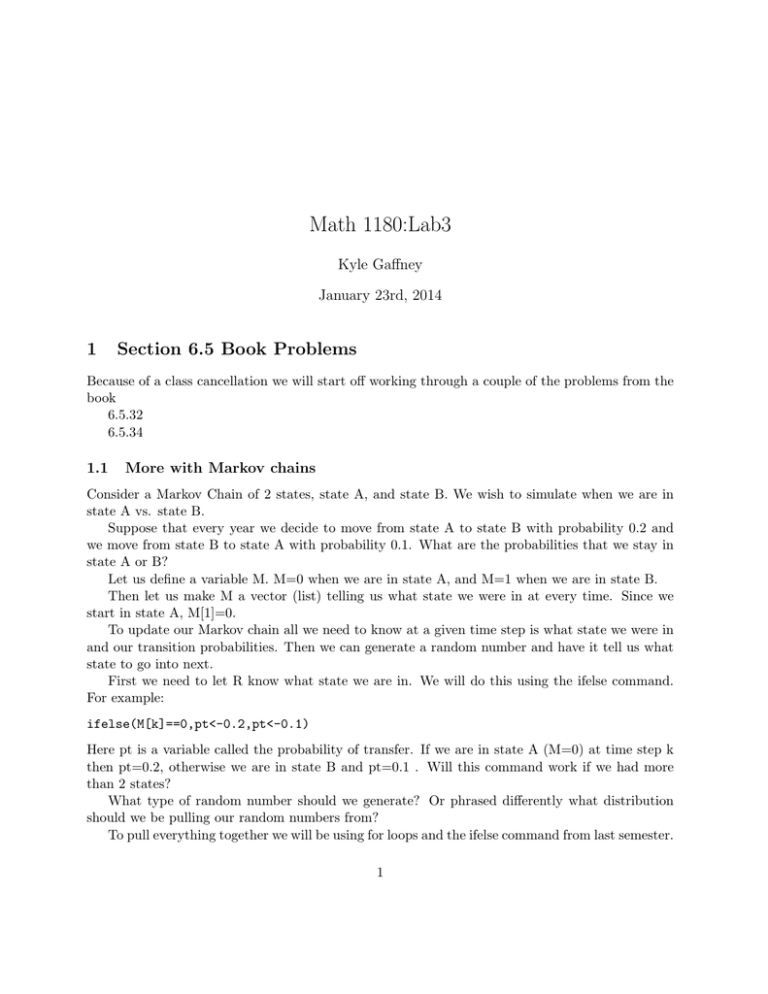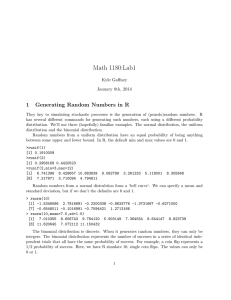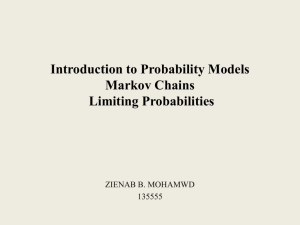Math 1180:Lab3 1 Section 6.5 Book Problems Kyle Gaffney
advertisement

Math 1180:Lab3
Kyle Gaffney
January 23rd, 2014
1
Section 6.5 Book Problems
Because of a class cancellation we will start off working through a couple of the problems from the
book
6.5.32
6.5.34
1.1
More with Markov chains
Consider a Markov Chain of 2 states, state A, and state B. We wish to simulate when we are in
state A vs. state B.
Suppose that every year we decide to move from state A to state B with probability 0.2 and
we move from state B to state A with probability 0.1. What are the probabilities that we stay in
state A or B?
Let us define a variable M. M=0 when we are in state A, and M=1 when we are in state B.
Then let us make M a vector (list) telling us what state we were in at every time. Since we
start in state A, M[1]=0.
To update our Markov chain all we need to know at a given time step is what state we were in
and our transition probabilities. Then we can generate a random number and have it tell us what
state to go into next.
First we need to let R know what state we are in. We will do this using the ifelse command.
For example:
ifelse(M[k]==0,pt<-0.2,pt<-0.1)
Here pt is a variable called the probability of transfer. If we are in state A (M=0) at time step k
then pt=0.2, otherwise we are in state B and pt=0.1 . Will this command work if we had more
than 2 states?
What type of random number should we generate? Or phrased differently what distribution
should we be pulling our random numbers from?
To pull everything together we will be using for loops and the ifelse command from last semester.
1
M<-0
n<-50
rn<-runif(n-1)
for (i in 2:n){ifelse(M[i-1]==0,pt<-0.2,pt<-0.1)
ifelse(rn<pt,M[i]<-1-M[i-1],M[i]<-M[i-1])}
plot(M)
Here rn is a list of random numbers that we will call upon to decide whether we stay or go. In
the for loop the first ifelse statement tells us what our probability of leaving is depending on what
state we are in. The second ifelse statement lets us know whether or not we transfer and updates
our state accordingly.
From lab 1 this is the code that we used to generate our sequence of random states for our
Markov chain. Now we would like to collect some statistics on our vector of states, M.
Time spent in each State:
Assuming that we spend 1 year in each state during each time step how long do we spend in
state A vs state B?
Since the entry of M=0 if we are in state A, and M=1 if we are in state B then:
sum(M)
Will tell us how long we were in state B, then n-sum(M) will be how long we were in state A.
Number of transitions made:
If we wish to find how many times we changed states from A to B and vice-versa we can do the
following:
sum(abs(diff(M)))
If a transition occurred then M[i+1]-M[i] will equal 1 or -1. the abs will make it 1, and then if we
sum over the whole state sequence this will tell us how many times we changed states.
2
Assignment for the week
Consider a 2 state Markov Process. By altering the code that is provided in the lab simulate 3
different processes, one where transitions rarely happen, one where transitions occur occasionally,
and one where almost every year a transition happens. Calculate the number of transitions and
the time spent in each state for each of the processes.
If you increased the time scale that we were looking at from 50 years to say 1 million years then
how often would you expect transitions to occur? In other words what is the long time behavior
of the different processes?
2







